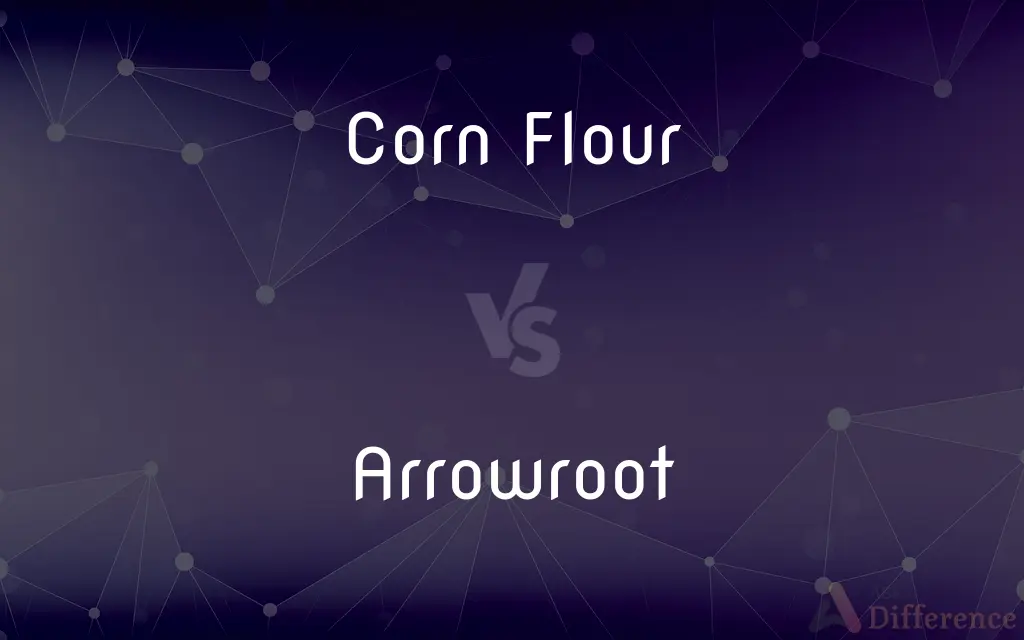Corn Flour vs. Arrowroot — What's the Difference?
By Tayyaba Rehman — Published on November 27, 2023
Corn flour is a finely ground powder made from corn, used as a thickener in cooking. Arrowroot is a starchy powder, often used as a substitute for corn flour, derived from the roots of the arrowroot plant and is gluten-free.

Difference Between Corn Flour and Arrowroot
Table of Contents
ADVERTISEMENT
Key Differences
Corn flour, obtained from the milling process of corn, is renowned for its application as a thickener in numerous culinary dishes. Arrowroot, a starchy substance extracted from various tropical plants, similarly stands out as a thickening agent, but distinctively, in clearer and glossier finishes in culinary items. Both corn flour and arrowroot are common in the culinary world, especially in sauces and gravies, though they derive from substantially different sources and have varying impacts on the consistency and appearance of dishes.
Corn flour often presents a slightly yellowish tint, impacting the color of the dishes it’s incorporated into. Conversely, arrowroot is typically neutral in color and therefore does not alter the visual aspect of a dish significantly. Both corn flour and arrowroot are utilized for their capacity to alter the consistency of food items, though the visual outcomes, particularly concerning color, can be notably different due to their individual characteristics.
In terms of nutritional value, corn flour often contains a modest amount of fiber and protein since it's derived directly from corn. Arrowroot, while not especially nutrient-dense, is acclaimed for being an easily digestible starch and is often recommended for dietary use in certain digestive conditions. While both corn flour and arrowroot are not particularly renowned for their nutritional benefits, subtle differences exist that can be significant in specific dietary contexts.
Allergenic considerations differentiate corn flour and arrowroot as well. Corn flour, being a corn product, can be allergenic to individuals with a corn allergy. Arrowroot is generally considered hypoallergenic and is often selected as a thickening agent for those with various food intolerances or allergies. While both products serve similar purposes in cooking, considerations regarding food allergies and intolerances can determine the preference between corn flour and arrowroot.
In relation to gluten content, corn flour does not contain gluten, making it a viable option in gluten-free cooking. Arrowroot is similarly gluten-free and can be utilized in various dishes where gluten presence is undesirable or harmful, such as in gluten-free baking. Both corn flour and arrowroot provide options for those adhering to gluten-free diets, though they may impart different textures and finishes to the final dish.
ADVERTISEMENT
Comparison Chart
Source
Corn
Tropical plants
Color
Usually yellowish
Generally neutral
Nutritional Content
Contains some fiber and protein
Not particularly nutrient-dense
Allergenic Considerations
Can be allergenic (corn allergy)
Generally considered hypoallergenic
Gluten Content
Gluten-free
Gluten-free
Compare with Definitions
Corn Flour
Corn flour is widely used as a thickening agent in cooking.
Corn flour made the sauce rich and creamy.
Arrowroot
Arrowroot is often utilized as a thickening agent in culinary dishes.
She added arrowroot to thicken the gravy without altering its color.
Corn Flour
Corn flour often possesses a slightly yellowish color.
The corn flour added a subtle yellow tint to the custard.
Arrowroot
Arrowroot can provide a clear, glossy finish to dishes.
To achieve a clear, shiny sauce, he stirred in arrowroot.
Corn Flour
Corn flour is gluten-free and used in various gluten-free recipes.
She opted for corn flour to make gluten-free bread.
Arrowroot
Arrowroot is a starchy substance derived from tropical plants.
Arrowroot provided the pie filling with a glossy finish.
Corn Flour
Corn flour is a finely ground powder made from corn.
She used corn flour to thicken the soup.
Arrowroot
Arrowroot is generally considered hypoallergenic.
For the allergy-friendly recipe, she used arrowroot instead of corn flour.
Corn Flour
Corn flour can be used in baking and cooking.
He replaced the wheat flour with corn flour in the cookie recipe.
Arrowroot
A starch obtained from the rhizomes of a tropical American perennial herb (Maranta arundinacea). It is used especially in cooking as a thickener.
Arrowroot
The rhizome of this plant, cooked and eaten as a vegetable or used for starch extraction.
Arrowroot
The plant itself.
Arrowroot
The edible starch obtained from the rhizomes or tubers of various other plants, including coontie.
Arrowroot
Any of these plants.
Arrowroot
Maranta arundinacea from the Marantaceae family, a large perennial herb native to the Caribbean area with green leaves about 15 centimeters long.
Arrowroot
Usually preceded by an attributive word: some other plant whose rhizomes are used to prepare a substance similar to arrowroot (sense 3), such as Zamia integrifolia (Florida arrowroot) or Pueraria montana var. lobata (Japanese arrowroot or kudzu).
Arrowroot
(uncountable) A starchy substance obtained from the rhizomes of an arrowroot plant used as a thickener.
Arrowroot
A white-flowered west Indian plant of the genus Maranta, esp. Maranta arundinacea, now cultivated in many hot countries. Its root yields arrowroot starch. It said that the Indians used the roots to neutralize the venom in wounds made by poisoned arrows.
Arrowroot
A nutritive starch obtained from the rootstocks of Maranta arundinacea, and used as food, esp. for children an invalids; also, a similar starch obtained from other plants, as various species of Maranta and Curcuma.
Arrowroot
A nutritive starch obtained from the root of the arrowroot plant
Arrowroot
White-flowered West Indian plant whose root yields arrowroot starch
Arrowroot
Canna grown especially for its edible rootstock from which arrowroot starch is obtained
Arrowroot
Arrowroot is gluten-free and can be used in various dietary applications.
He used arrowroot to make the gluten-free cake binder.
Common Curiosities
Is arrowroot a type of flour?
Arrowroot is not a flour but a starchy substance derived from tropical plants.
Can corn flour be used in gluten-free recipes?
Yes, corn flour is gluten-free and can be used in gluten-free recipes.
Does arrowroot alter the color of dishes?
No, arrowroot is neutral in color and generally doesn’t affect the color of dishes.
What is corn flour made from?
Corn flour is made from finely ground corn.
Can corn flour be used as a thickening agent?
Yes, corn flour is commonly used to thicken sauces, soups, and stews.
Is arrowroot hypoallergenic?
Generally, yes, arrowroot is considered hypoallergenic.
Can arrowroot be used in baking?
Yes, arrowroot can be used as a binding or thickening agent in baking.
Does corn flour contain gluten?
No, corn flour is naturally gluten-free.
Can I substitute corn flour for wheat flour in baking?
Yes, but it may alter the texture and flavor, and ratios may need adjusting.
Is corn flour the same as cornmeal?
No, corn flour is more finely ground than cornmeal.
Is corn flour considered hypoallergenic?
No, corn flour may cause issues for those with a corn allergy.
What is the primary use of arrowroot in cooking?
Arrowroot is primarily used as a thickener and to provide a glossy finish to dishes.
Can arrowroot replace corn flour in recipes?
Yes, arrowroot can replace corn flour, especially as a thickening agent.
Does arrowroot have a strong flavor?
No, arrowroot is relatively flavorless and doesn’t impact the taste of dishes.
Can corn flour and arrowroot be used interchangeably?
Often, yes, but textures and finishes may slightly differ in the final dish.
Share Your Discovery

Previous Comparison
Lanthanoids vs. Actinoids
Next Comparison
Christmas vs. New YearAuthor Spotlight
Written by
Tayyaba RehmanTayyaba Rehman is a distinguished writer, currently serving as a primary contributor to askdifference.com. As a researcher in semantics and etymology, Tayyaba's passion for the complexity of languages and their distinctions has found a perfect home on the platform. Tayyaba delves into the intricacies of language, distinguishing between commonly confused words and phrases, thereby providing clarity for readers worldwide.













































